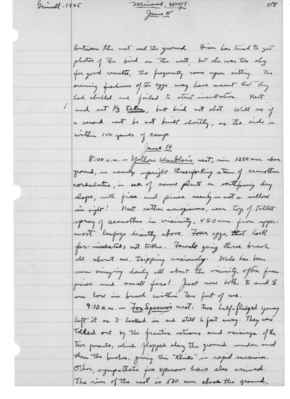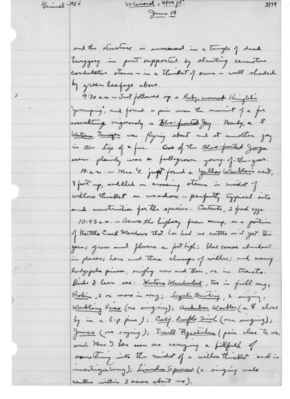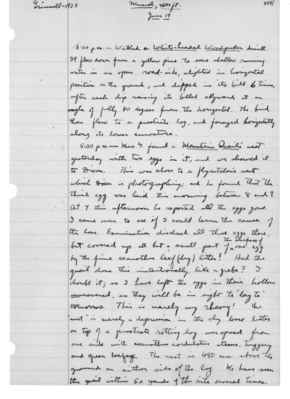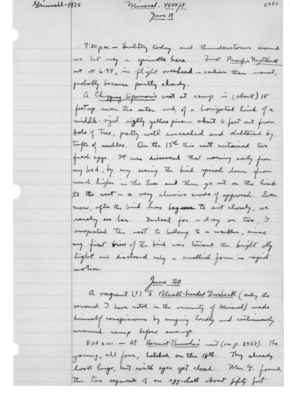Pages That Mention 1925-06-19
1925: Joseph Grinnell's field notes
S2 Page 23
Collector: Grinnell-1925 Location: Mineral, 4800 ft. Date: June 18 Page Number: 2478
between the nest and the ground. Dixon has tried to get photos of the bird in the nest, but she was too shy for good results, tho frequently came upon sitting. The seeming freshness of the eggs may have meant that they had chilled and failed to start incubation. Nest and set 1/3 taken, but bird not shot. Will see if a second nest be not built shortly, as the site (?) is within 100 yards of camp.
June 19 8:00am - Yellow Warbler's nest, rim 1280 mm. above ground, in nearly upright tree for three-forking stem of ceanothus cordulatus, in sea of same plant on north facing dry slope, with firs and pines nearby -- not a willow in sight! Nest rather conspicuous, near top of tallest spray of ceanothus in vicinity, 450 mm. from upper most leafage directly above. Four eggs, that look far-incubated; not taken. Female going thru brush all about us, tripping anxiously. Male has been seen singing daily all about the vicinity, often from pines and small firs! Just now both (male) and (female) are low in brush within ten feet of me.
9:10am -- Fox Sparrow's nest: two half-fledged young left it as I looked in and still 6 feet away. They were tolled out by the frantic actions and voicings of the two parents, which flopped along the ground under and thru the bushes, giving their "klinks" in rapid succession. Other, sympathetic fox sparrows have also arrived. The rim of the nest is 530 mm. above the ground,
S2 Page 24
Collector: Grinnell-1925 Location: Mineral, 4800 ft. Date: June 19 Page Number: 2479
and the structure is ensconced in a tangle of dead twiggery in part supported by slanting ceanothus cordulatus stems - in a thicket of same - well shaded by green leafage above.
9:30 a.m. - Just followed a Ruby-crowned Kinglet's "yerruping," and found a pair upon the summit of a fir assaulting vigorously a Blue-fronted Jay. Nearby, a (female) Western Tanager was flying about and at another jay in the top of a fir. One of the Blue-fronted Jays seen plainly was a full-grown young-of-the-year.
10: a.m. - Mrs. G. just found a Yellow Warbler's nest, 8 feet up, saddled on crossing stems in midst of willow thicket on meadow - perfectly typical site and construction for the species. Contents, 2 fresh eggs.
10:45 a.m. - Across the highway from camp, on a portion of Battle Creek Meadows that has had no cattle on it yet this year; grass and flowers a foot high; blue camas abundant in places; here and there clumps of willow; and many lodgepole pines, singly now and then, or in tracts. Birds I hear are: Western Meadowlark, two in full song; Robin, 2 or more in song; Lazuli Bunting, 2 singing; Warbling Vireo (one singing); Audubon Warbler (a (female) close by in a l-p pine); Calif. Purple Finch (one singing); Junco (one singing); Traill Flycatcher (pair close to me, and Mrs. G has seen one carrying a billfull of something into the midst of a willow thicket and in investigating); Lincoln Sparrow (a singing male centers within 3 acres about us).
S2 Page 25
Author: Grinnell-1925 Location: Mineral, 4800 ft. Date: June 19 Page Number: 2480
Later: found the Traill Flycatcher's nest some 7 feet up in a crotch of slender willow stem in the midst of an isolated willow clump in the meadow - just in process of construction. In a tract of old lodge pole pines a little farther along, a crowd of birds was distraught over something, tho I failed to find what the threatening danger was. The crowd included: Juncos, a pair of Robins, a Lincoln Sparrow, a Pigmy Nuthatch (the first I have seen in the Lassen "section"), a Hammond (or Wright) Flycatcher, several Chipping Sparrows, and a pair of Audubon Warblers. Nearby was a (female) White-headed Woodpecker.
As to mammals: winter earthcores of Thomomys monticola occur in places where the ground is well-drained at the sides of meadows but not out in them. The common chipmunk is Eutamias amoenus, about logs overgrown with snowbushes, but they are very quiet now; two visit camp, but so far are shy. A (female) Eutamias senex was trapped in a neighbor's camp yesterday morning at 5 o'clock. Last evening just before sundown, Dixon shot an old male jack-rabbit (Lepus c. californicus) in a tract of sparse snowbush. Mrs. G. has seen another partly grown one in the same vicinity. This must be the extreme easternmost limit of this subspecies in the "section". Also, Mrs. G. and Dixon have both seen individuals of the snow-shoe rabbit (Lepus w. klamathensis).
S2 Page 26
Collector: Grinnell-1925 Location: Mineral, 4800 ft. Date: June 19 Page Number: 2481
3:00 p.m. - Watched a White-headed Woodpecker drink. It flew down from a yellow pine to some shallow running water in an open road-side, alighted in horizontal position on the ground, and dipped it's bill 6 times, after each dip raising its billed skyward at an angle of fully 80 degrees from the horizontal. The bird then flew to a prostrate log, and foraged horizontally along its lower curvature.
5:00 p.m. - Mrs. G found a Mountain Quail's nest yesterday with two eggs in it, and we showed it to Dixon. This was close to a flycatcher's nest which Dixon is photographing; and he found that the third egg was laid this morning between 8 and 9. At 4 this afternoon he reported all the eggs gone. I came over to see if I could learn the cause of the loss. Examination disclosed all three eggs there, but covered up all but a small part of the surface of one egg, by the fine ceanothus leaf (dry) litter! Had the quail done this intentionally, like a grebe? I doubt it; so I have left the eggs in their hollow uncovered, so they will be in sight to "lay to" tomorrow. This is merely my theory! The "nest" is merely a depression in the dry loose litter on top of a prostrate rotting log, overspread from one side with ceanothus cordulatus stems, twiggery and green leafage. The nest is 480 mm. above the ground on either side of the log. We have seen the quail within 50 yards of the site several times.
S2 Page 27
Collector: Grinnell-1925 Location: Mineral, 4800 ft. Date: June 19 Page Number: 2482
7:30 p.m. - Sultry today and thunderstorms around us but only a sprinkle here. First Pacific Nighthawk out at 6:45, in flight overheard - earlier than usual, probably because partly cloudy.
A Chipping Sparrow's nest at camp is (about) 18 feet up near the outer end of a horizontal limb of a middle-sized sickly yellow pine - about 6 feet out from bole of tree, pretty well concealed and sheltered by tufts of needles. On the 13th this nest contained two fresh eggs. It was discovered that morning early from my bed, by my seeing the bird spiral down from much higher in the tree and then go out on the limb to the nest - a very elusive mode of approach. Even now, after the bird has begun to sit closely, we rarely see her. Indeed for a day or two, I suspected the nest to belong to a warbler, since my first view of the bird was toward the bright sky light and disclosed only a smallish form in rapid motion.
June 20. A vagrant (?) [male symbol] Black-headed Grosbeak (only the second I have noted in the vicinity of Mineral) made himself conspicuous by singing loudly and continuously around camp before sun-up.
8:00 a.m. - At Hermit Thrushes' nest (see p. 2468). The young, all four, hatched on the 18th. They already look huge, but with eyes yet closed. Mrs. G. found the two segments of an eggshell about fifty feet




